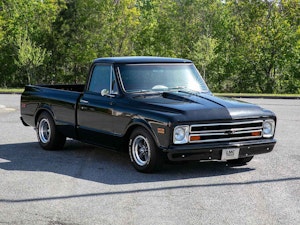Media | Articles
Never Stop Driving #11: What is a car?
If there’s no steering wheel, is a car still a car? GM and Ford have each asked NHTSA to grant them permission to deploy 2500 vehicles without manual controls like steering wheels and pedals. The 2500 vehicles per manufacturer—the most NHTSA can approve—is the next step in a wider rollout of autonomous vehicles.
GM, through its Cruise subsidiary, wants to deploy vehicles without steering wheels, mirrors, turn signals, or windshield wipers, according to Automotive News. Pretty wild, but Cruise’s plans make sense: it’s not like the car is actually looking out the windshield.
Crashes are going to happen and the petitions were sent to NHTSA months ago, but we’re just now finding out that a Cruise passenger was sent to the hospital in that June crash where the car came to a stop in an intersection and was T-boned by an oncoming (human-driven) Uber. If they were both robotaxis, it’s worth noting, that crash likely would not have occurred. Still, not a good look for Cruise.
The path to a robotaxi future, like autonomous trucks, is accelerating quickly. Zoox, an autonomous car company owned by Amazon, is also gearing up to test an autonomous taxi service in California. Its “car,” which doesn’t have any manual controls, uses a carbon-fiber main structure, a construction similar to modern supercars.
The big American automakers aren’t the only ones going down this path, either. Chinese search engine giant (and autonomous carmaker) Baidu showed off its new autonomous robotaxi with a detachable steering wheel at a conference last week. The new car, which will cost roughly the equivalent of $37,000, is almost half the projected cost of its prior-generation autonomous ride. Baidu says its Level 4 robotaxi has the same performance as a human with 20 years of driving experience.
Marketplace
Buy and sell classics with confidence
Whew. I’m having a hard time concentrating on anything but this Shelby Cobra that I can’t afford. Chassis CSX2171, which has never been restored and looks a little rough, will be auctioned next month at Pebble Beach. My colleague Andrew Newton drove it and confirmed that it’s a time capsule to lust after.
My intense interest in the Cobra is surprising even to me since I’ve long espoused the value of tributes and copycat cars. I’ve owned a 1965 Mustang that was customized in honor of a Shelby GT350 and a 1969 Chevy wagon that had the stripes and graphics—and a big-block V-8—of a Chevy modified by Yenko, but which was not a real Yenko Chevy. I owned it and drove it with pleasure and without apology.

There’s something about that original Cobra, something compelling about the hands that touched it. The short and intense life of Carrol Shelby’s little factory, which existed for less than a decade, is fascinating and well told in this book by our own Colin Comer. Since I don’t have the means to own one of Shelby’s cars, perhaps I’ll douse my sorrows with these new, muscle-car stamps.
I hope you’ll find time to get behind the wheel this weekend, but during your downtime, perhaps you’ll enjoy the latest from Hagerty Media.
Rob Siegel on the genius of a parts car
How to drive your car on a racetrack by Steven Cole Smith
Grace Houghton reveals that Volvos are still cheap
And a terrific long read about a hometown Nash by Eric Weiner
Hear from me every Friday by subscribing to this newsletter.









